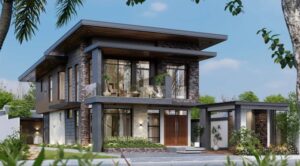
The wellness real estate trend is transforming how we view and engage with our living environments. As people increasingly prioritize health and well-being, properties that incorporate wellness features are gaining traction in the market. From improved air quality systems and natural lighting to access to green spaces, these elements are not just luxury add-ons but essential components that enhance quality of life.
This shift in perspective has significantly influenced buyer preferences and property values. As more individuals seek spaces that promote physical and mental wellness, the real estate market is responding dynamically to these evolving demands. This landscape opens up exciting opportunities for both homebuyers and investors alike.
Overview of Wellness Real Estate Trend
The wellness real estate trend has emerged as a vital component in the property market, representing a shift towards creating living spaces that prioritize health and well-being. This concept has gained traction as individuals increasingly recognize the connection between their living environments and overall wellness. Features such as improved air quality systems, abundant natural lighting, and access to green spaces are becoming essential elements in residential properties.Wellness real estate significantly impacts buyer preferences and property values, as potential homeowners are now more inclined to invest in properties that cater to their health needs.
Features like high-quality air filtration systems, abundant windows for natural light, and nearby parks or gardens not only enhance the living experience but also contribute to better mental and physical health. Consequently, properties that incorporate these wellness features are often valued higher in the market, reflecting the growing demand for healthier living options.
Real Estate Market Trends
Current trends in the real estate market show a marked increase in the demand for wellness-focused properties. This shift has been partially influenced by the COVID-19 pandemic, which heightened awareness of health and safety in home environments. As remote work became the norm, many individuals started to prioritize homes that offered more than just a place to live, leading to a significant demand for wellness amenities.Demographic shifts, particularly among millennials and Gen Z, are also shaping the landscape of wellness real estate.
These younger generations tend to value sustainable living and are more conscious of their health, driving a preference for properties that reflect these ideals. This has led to an increased interest in developments that offer wellness-centric features, much like community gardens, fitness centers, and holistic health services.
Real Estate Investment Opportunities
Investing in wellness real estate presents a unique opportunity for savvy investors. Strategies in this niche can involve targeting properties that already incorporate wellness features or investing in developments specifically designed with health in mind. The potential returns on wellness properties often surpass those of traditional real estate investments, as demand for healthier living options continues to rise.Financing options for wellness real estate projects are diversifying, with lending institutions increasingly recognizing the value of properties designed for health and well-being.
Investors can explore various funding avenues, including green mortgages that provide incentives for sustainable building practices, making it easier to finance wellness-centric developments.
Smart Home Technology in Wellness Real Estate
The integration of smart home technology plays a crucial role in promoting wellness within real estate. Smart devices can enhance health and well-being by monitoring air quality, regulating temperature, and controlling lighting. For instance, smart thermostats optimize heating and cooling to ensure comfort while also promoting energy efficiency, further aligning with wellness goals.Examples of smart devices that enhance health include air purifiers equipped with IoT technology, smart lighting systems that adjust according to natural light levels, and wellness tracking devices that monitor physical activity and sleep patterns.
The future of smart homes within the wellness real estate trend looks promising, as advancements in technology continue to create more integrated and health-focused living environments.
Commercial Real Estate and Wellness

Wellness trends are not only influencing residential real estate but are also making significant strides in the commercial sector. Companies are increasingly recognizing the importance of employee well-being, leading to the design of office spaces that promote health. Features such as open floor plans, biophilic design elements, and access to natural light are becoming standard in modern offices.Successful commercial properties emphasizing wellness include buildings with green roofs, fitness amenities, and spaces designed to encourage movement, like walking paths.
These design elements help enhance productivity and employee satisfaction, ultimately benefiting businesses through improved performance and reduced absenteeism.
Luxury Homes and Wellness Features
The incorporation of wellness amenities into luxury homes has become a defining characteristic of high-end properties. Features such as home gyms, spas, and private gardens are increasingly sought after by discerning buyers who prioritize their health and lifestyle. The market demand for luxury homes with wellness features is on the rise, as more affluent individuals look for properties that not only offer opulence but also promote well-being.Examples of luxury properties successfully integrating wellness designs include estates with dedicated wellness rooms, outdoor meditation areas, and advanced home automation systems that monitor health metrics.
These features not only enhance the living experience but also significantly increase the property’s value in the competitive luxury market.
Luxury Real Estate Market Trends
Trends within the luxury real estate market are increasingly reflecting a focus on wellness. Luxury buyers are prioritizing homes that offer wellness features, recognizing their importance in enhancing quality of life. For instance, properties with organic gardens, air purification systems, and relaxation spaces are becoming more appealing to high-net-worth individuals.Pricing differences between luxury wellness properties and traditional luxury homes are evident, with wellness-centric features justifying higher price points.
As the awareness of health and well-being continues to grow among affluent buyers, properties that incorporate these elements are likely to see sustained demand and appreciation in value.
Last Word
In conclusion, the wellness real estate trend is more than a passing fad; it represents a fundamental change in how we approach living spaces. With a growing emphasis on health-enhancing features, properties that prioritize wellness are poised to shape the future of real estate. As this trend continues to evolve, it promises to redefine our expectations of home and community.
Expert Answers
What is wellness real estate?
Wellness real estate focuses on properties designed to promote health and well-being, incorporating features like air quality systems and access to nature.
How has COVID-19 impacted wellness real estate?
The pandemic has heightened awareness of health and wellness, leading to increased demand for properties that prioritize these aspects.
What are some common wellness features in homes?
Common features include natural lighting, enhanced air filtration systems, spaces for exercise, and access to green areas.
Are wellness properties more expensive?
While they can be pricier due to their features, many buyers are willing to pay a premium for the health benefits they provide.
How can I invest in wellness real estate?
Investors can explore residential and commercial properties that emphasize wellness, while considering financing options tailored for these types of developments.







